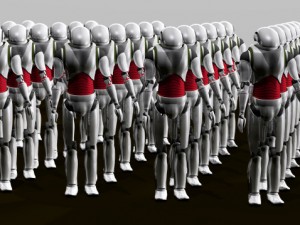The Spirit of Automation (Part 3)
By Asher Crispe: March 13, 2013: Category Inspirations, Living with the Times
 While there is much that can be said of the distinction between work and rest, the unexplored terrain that sits in the valleys between these experiential peaks and marks a transitional space bears even greater significance. Beyond the binary thinking that maintains their total opposition–where labor is allergic to relaxation and concerns over productivity shatter the calm of our repose–the in-between or overlapping states prove much more useful for our coming to terms with the warp and woof of today’s complicated ‘domestic’ work place. Somehow we have become enamored with the prospect of folding previously isolated domains within our lives, one upon the next.
While there is much that can be said of the distinction between work and rest, the unexplored terrain that sits in the valleys between these experiential peaks and marks a transitional space bears even greater significance. Beyond the binary thinking that maintains their total opposition–where labor is allergic to relaxation and concerns over productivity shatter the calm of our repose–the in-between or overlapping states prove much more useful for our coming to terms with the warp and woof of today’s complicated ‘domestic’ work place. Somehow we have become enamored with the prospect of folding previously isolated domains within our lives, one upon the next.
That being said, the essentialized or absolutized nature of work requires the continuous exertion of effort. Specific to the human sphere (as compared with deployment of machinery), we must involve and occupy ourselves with the task at hand. Our work is our occupation. It keeps us preoccupied. Yet, is there not another possibility? When we assemble systems of support that automate our work, are we not mimicking the autonomic nervous system that functions below the level of consciousness, where it’s there all along quietly humming in the background and ideally unnoticed? What would be the ultimate achievement of automation then? When we see a finished product (cakes, shoes, cars, computers, etc…) our first impression is not that these things made themselves, and yet nonetheless, we are waking up to the nascent stages of the self-assembly revolution. Things which naturally occur, hands-free assemblages without our consistent interference, seem to make themselves. The work then shifts to the setup. Subsequently the algorithms can run on their own.
The ‘party rock’ notion of ‘everybody working for the weekend’ doesn’t really do justice to the configuration of time into six days of work (the setup and assembly process) and one day of rest (the Sabbath as the automated run). Our extensive preparedness eventually allows us to sit back and ‘eat’ whilst resting. A practical example of work pushing forward until it transitions into rest would be the formulation of synthetic compounds such as self-healing paint or cement which when cracked ‘regrow’ themselves over the damaged region by means of naturally occurring reactions (yes–these already do exist!). This kind of autopoiesis would be akin to the kabbalistic notion of the weekdays becoming elevated as they enter into the Sabbath. Not that they shuttle our activities to the doorstep of the Sabbath and then dissolve but that they actually penetrate into the reality of the Sabbath. A set of six days is ‘consumed’ on the Sabbath which reproduces all of the previous time but with an additional dimension which strips away the ‘work’ of work and replaces it with work as rest.
The six week days are likened to six spatial extremities throughout which we are always on the move. When we are finished going though the motions (a series of performance instructions) then we can take the contents of this creative work with us as we ascend to an automated system. If the Sabbath is observed fully, then it means that it works so well (the six days) that the convergence point in the seventh (the node which binds and unifies the other six) happens all by itself. Sometimes the Sabbath is associated with reflected light (ohr chozer) in Jewish mystical texts which is similar to the idea of recursion in a complex system. It keep goings through successive iterations without the need for continual input due to the self-fertilizing quality of its reproduction.
In order to understand this, just imagine a 3D printer which can print gazillions of objects including another 3D printer like itself and then that 3D printer can itself beget even more offspring like itself with the same self-replicative capacity (this too has been done). Another popular example (still theoretical for now) would be a robot which once assembled could build another robot just like itself which could in turn repeat this same process ad infinitum if assured unlimited access to the requisite building materials. Surely, the impact of such an innovation would rewrite the economic textbooks and have far reaching implications which boggle the mind.
Consequently, the unification of the weekdays or ‘work’ days (mundane temporality) with the Sabbath (Sacred time) retroactively reinscribes the build up to automation with new significance. It means that everything we do is part of a process. We aren’t merely working but working towards something and that something incorporates all of the previous work without having to rework it. For instance, once we figure out how to make a new device such as an iPad, each copy of that device ideally follows an identical process. Thus, if it has a fixed set of instructions and the end product is identical, then it can be automated.
Beyond the ingress of work into rest (when we are no longer ‘occupied’ with production), there is the reverse situation where the rest of the Sabbath descends into the weekdays. In this case, there is a residual effect of having achieved inner attunement or rest that is carried forth into the mundane realm. This top-down unification converts the Sabbath into the soul of the six days of the week which are the relative body. An inner sense of rest vitalizes and inspires all of our expanding activities. When I feel comfortable with some tool or instrument then it becomes part of my extended body (the tennis racket is an extension of my arm or my computer an extension of my brain). When we become fluent enough in an action, then we don’t have to think about its performance in the same way as we once did when we started learning about it. Along these lines–once we acquire the skills, we do not need to look at the keyboard when we are typing or playing the piano. It’s almost like our fingers have developed an instinctual sense of where they need to be placed and then go there automatically. These are ‘weekday Sabbath’ activities (weekday activities inspired by the Sabbath) as opposed to ‘Sabbath weekday’ activities (where the work of the week is lifted into Sabbath automation mode).
 Even more varied creative tasks such as writing an essay or solving a math problem may start to flow out of me with minimal resistance. Once we enter the ‘zone’ (Sabbath) then everything starts to flow (weekday work is ‘discontinuous’ and broken up [six days] while Sabbath states are continuous and unified [one day]). Taking that elevated sense of flow and introducing it into the daily grind is like a fuel injection. Suddenly, the pain of work is gone and I am being super-productive. Ideas keep coming to me. I am writing as fast as I can and can’t keep up with the fountain of new thoughts. Tasks which once required weeks or days now somehow get compressed into hours and minutes. I’m working in the groove. I’m flying. Outwardly I may appear to be sprinting but inwardly I am at peace with the game. It’s play time. I am ‘being at home’ (psycho-spiritually) within the work itself. As such, I am no longer aliened by my labor which has now become sweetened.
Even more varied creative tasks such as writing an essay or solving a math problem may start to flow out of me with minimal resistance. Once we enter the ‘zone’ (Sabbath) then everything starts to flow (weekday work is ‘discontinuous’ and broken up [six days] while Sabbath states are continuous and unified [one day]). Taking that elevated sense of flow and introducing it into the daily grind is like a fuel injection. Suddenly, the pain of work is gone and I am being super-productive. Ideas keep coming to me. I am writing as fast as I can and can’t keep up with the fountain of new thoughts. Tasks which once required weeks or days now somehow get compressed into hours and minutes. I’m working in the groove. I’m flying. Outwardly I may appear to be sprinting but inwardly I am at peace with the game. It’s play time. I am ‘being at home’ (psycho-spiritually) within the work itself. As such, I am no longer aliened by my labor which has now become sweetened.
Now that we have introduced work within rest (automation) and rest within work (flow) we will go on to show these states in a broader existential context in Part Four.
http://www.interinclusion.org/inspirations/the-spirit-of-automation-part-4/
The Spirit of Automation (Part 3),
















;)
;)
;)
;)
;)
;)
;)
;)
;)
;)

Your words are like poetry… always piquing my interest… begging to be reread. The weekdays and the 7th day Sabbath now become “The age that is all Sabbath.” Not a week broken into 7 parts but “a week with a singularity of meaningful purpose.”